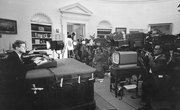Toward the end of World War II, leaders from the United States, Britain and the Soviet Union met to discuss the fate of Europe after the war. It was agreed that the USSR would oversee a sphere of influence in Eastern Europe and the western powers would oversee a sphere of influence in Western Europe. This led to the rise of the world's two major superpowers, the United States and the USSR. The superpowers' conflicting ideologies -- capitalism and communism -- gave rise to the Cold War, in which both nations attempted to gain influence in the world without openly engaging in war with one another. The Cold War continued until the dismantling of the USSR in 1991.
Soviet Sphere of Influence
The USSR liberated Poland and Czechoslovakia from German occupation. They Soviets also occupied Romania, Bulgaria and Hungary -- all allies of Nazi Germany -- before occupying eastern Germany. As a result, these areas fell under Soviet influence. In the years immediately following World War II, the USSR established Soviet-style communist governments in these countries, which became known as the Soviet Bloc. The USSR maintained a strong military presence in these countries throughout the Cold War. The Soviets also developed strong economic ties by providing aid to help these countries rebuild after the war.
Warsaw Pact
The United States and its Western European allies formed the North Atlantic Treaty Organization (NATO) in 1949 because of growing concerns about Soviet expansion. The Soviet Union, in turn, formalized its military relations with the Soviet Bloc through the Warsaw Pact. The stated reasons for forming the Warsaw Pact had to do with mutual defense, but the USSR also used its Warsaw Pact allies to indirectly promote communism in third-world countries. The main reason the Soviets used allied countries to provide aid to these developing countries was to avoid direct confrontation with the United States, which generally supported democratic or capitalist governments in the same countries.
Military Aid
The Soviet Union was founded on the Marxist revolutionary ideal that the working classes of the world would rise up to overthrow those who controlled the wealth in their countries. In keeping with this ideal, the USSR gave military aid to several countries' communist uprisings. This was usually in the form of weapons or military advisors rather than direct military intervention. The USSR aided the successful communist revolutions in China, Cuba and Vietnam. It also gave military aid -- generally through its allied countries -- to communist uprisings in Yugoslavia, Albania, Korea and several Latin American and African countries.
Economic Aid
In addition to military aid, the USSR -- again, usually through its satellite countries -- gave economic aid to countries that were heading toward communism. In some cases, this came in the form of favorable trade arrangements. In other cases, aid came in the form of providing economic advisors to help developing countries transition to socialist economic systems. Many of the people in third-world countries felt exploited by European and American colonialism. They viewed the Soviet offer of economic and military aid as an opportunity to liberate their countries from foreign influence and to provide a more equitable life for their poor and working-class people.
Related Articles
References
Writer Bio
Dell Markey is a full-time journalist. When he isn't writing business spotlights for local community papers, he writes and has owned and operated a small business.











